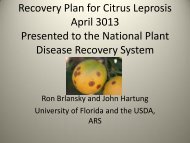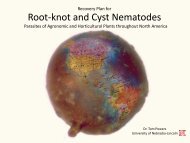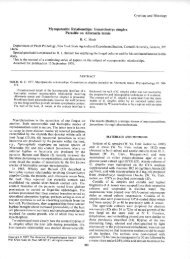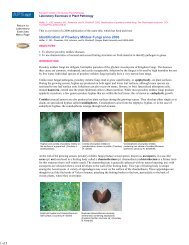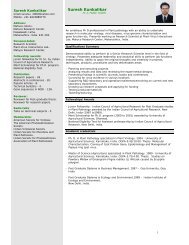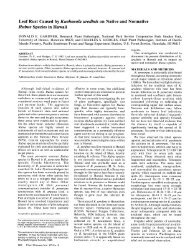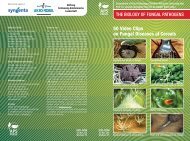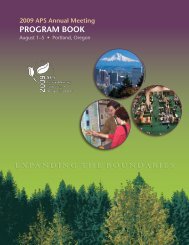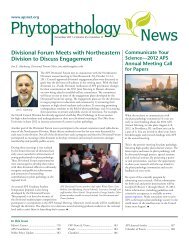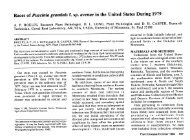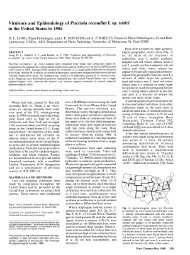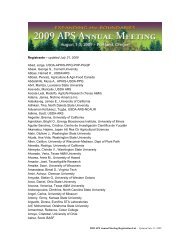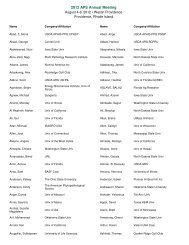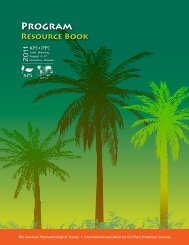view article - American Phytopathological Society
view article - American Phytopathological Society
view article - American Phytopathological Society
Create successful ePaper yourself
Turn your PDF publications into a flip-book with our unique Google optimized e-Paper software.
The nit-2 gene of N. crassa encodes an activator protein that<br />
governs overall nitrogen metabolism in the cell. We have used<br />
the cloned gene as a heterologous probe to survey various<br />
fungal phytopathogens for homologues. A wide variety of genera<br />
showed homology as determined by Southern blotting. To further<br />
study nitrogen regulation, we have chosen Fusarium app.<br />
Genomic libraries of Fusarium moniliforme and Fusarium sacchari<br />
have been constructed. Following screening, we have isolated a<br />
6kb fragment from both fungi with homology to the nit-2 gene<br />
from N. crassa. We also used the nit-2 gene to complement a<br />
mutant of Fusarium graminearum that is defective in overall<br />
nitrogen metabolism. Following transformation colonies were<br />
obtained which now could utilize nitrogen sources similar to<br />
the wildtype. This suggests that this heterologous regulatory<br />
gene is expressed in Fusarium and functions to activate<br />
expression of nitrogen regulated genes in this organism.<br />
297<br />
STRUCTURAL AND FUNCTIONAL ANALYSES OF TWO Q-TUBULIN GENES IN<br />
COLLETOTRICHUN GRAMINICOLA. D. G. Panaccione and R. M. Hanau.<br />
Dept. of Botany and Plant Pathology, Pudue University, West<br />
Lafayette, IN 47907.<br />
In organisms with multiple tubulin genes, expression of<br />
individual tubulin genes is often developmentally regulated.<br />
Two S-tubulin genes, TUBI and TUB2, were cloned from<br />
Colletotrichum graminicola with the interest of studying their<br />
involvement in conidial development. Southern hybridization<br />
and DNA sequencing demonstrated that although the two genes<br />
are considerably divergent, they both have the capacity to<br />
encode 3-tubulin. RNA blots indicated that the level of TUB2<br />
message relative to TUBI message increased in conidiating<br />
cultures. To study the functional significance of this, the<br />
TUB2 gene was replaced with a truncated copy of the gene by<br />
site-specific integrative transformation. Transformants<br />
carrying the truncated TUB2 allele did not display any<br />
294 abnormalities in conidial development.<br />
IDENTIFICATION OF SEQUENCES WITH PROMOTER ACTIVITY FROM 298<br />
GIBBERE1IXA PULICARIS (FUSARIUM<br />
Yangkyo<br />
SAMBUCINUM)<br />
P. Salch and<br />
TRANSFORMANTS.<br />
Marian N. Beremand, USDA, Agricultural<br />
Research Service,<br />
TRANSFORMATION<br />
Northern Regional<br />
OF TRICHODERMR<br />
Research<br />
SPP.<br />
Center,<br />
TO HYGROMYCIN<br />
Peoria,<br />
B RESISTANCE.<br />
A. Siva, TE. Stasz, G.E. Harman and M. Hemmat,<br />
IL 61604<br />
Dept. of Horticult<br />
Sciences, Cornell Univ., Geneva, NY, 14456.<br />
G. pulicaris (GP) is a heterothallic<br />
rot on potato<br />
ascomycete<br />
tubers.<br />
and<br />
GP<br />
causes<br />
protoplasts<br />
dry<br />
were transformed with a<br />
cosmid<br />
r<br />
cosHygl containing<br />
protoplasts<br />
hygromycin<br />
were obtained<br />
B phosphotransferase<br />
by digesting mycelium with<br />
Novozyme<br />
(hygB) fused<br />
234.<br />
to<br />
Protoplasts<br />
promoter<br />
were<br />
1 from<br />
treated<br />
Cochliobolous<br />
with the plasmid<br />
heterostrophus.<br />
pH11B (obtained<br />
Transformation<br />
from O.C.<br />
occurred<br />
Yoder) containing<br />
by random an<br />
integration<br />
Escherichia<br />
of the<br />
col<br />
cosmid<br />
hygromycin B<br />
phosphotransferase gene, which was used<br />
into<br />
with<br />
the GP<br />
the<br />
genome.<br />
permission<br />
Based on restriction of<br />
digestion<br />
Eli<br />
and<br />
Lilly &<br />
Southern<br />
Co., fused to a Cochliobulus<br />
hybridization<br />
heterostrophus promoter. Treated<br />
analyses,<br />
protopla<br />
one of the transformants with<br />
a single<br />
Co.,<br />
copy<br />
fused<br />
insertion,<br />
to a m<br />
63C3, had the recombination promoter<br />
event<br />
Tred prtopasts<br />
were<br />
occurring<br />
plated in<br />
between<br />
a molten<br />
the<br />
agar<br />
5'<br />
medium<br />
end of<br />
which<br />
hygB<br />
later<br />
coding<br />
was<br />
sequence<br />
covered with<br />
and<br />
a second<br />
the<br />
end<br />
3'<br />
of promoter 1.<br />
medium<br />
Expression<br />
layer<br />
of<br />
containing<br />
hygB resistance<br />
the antibiotic.<br />
most<br />
The<br />
likely<br />
application time<br />
antibiotic<br />
of the<br />
resulted from endogenous GP<br />
was<br />
promoter-like<br />
critical and differed<br />
sequences.<br />
between<br />
Cloning<br />
strains. Southern analysis<br />
putative<br />
of<br />
and analysis of<br />
transformants<br />
the GP promoter-like<br />
showed integration<br />
sequences<br />
into<br />
will<br />
the<br />
be<br />
genomic DNA. The<br />
frequency of transformed nuclei in hygromycin B resistant isolates was<br />
discussed.<br />
usually lower than 1%. Therefore,<br />
were<br />
nuclei<br />
allowed<br />
from<br />
to segregate<br />
all putative<br />
through conidiation.<br />
transformants<br />
Single spore isolates were<br />
295 obtained that were mitotically stable on selective and non selective media.<br />
CAROTENOID-OVERPRODUCING TRANSFORMANTS OF =]RQýBRQFAQM5 ARE<br />
NOT RESISTANT TO CERCOSPORIN. _ C og_Qpperman, M. E. Daub, R 299<br />
G. Carolina Upchurch, State and University, G. A. Payne. Raleigh, Dept. of NC Plant 27695-7616. Pathology, North<br />
HEAT SHOCK-INDUCED DEVELOPMENT OF INFECTION STRUCTURES BY THE<br />
The photoactivated toxin cercosporin<br />
RUST FUNGI:<br />
produces<br />
EXPRESSION<br />
singlet<br />
OF<br />
oxygen<br />
THE INF GENES.<br />
Staples,<br />
S. Bhairi<br />
Boyce<br />
and R.C.__<br />
Thompson Institute,<br />
and<br />
Cornell<br />
superoxide. University,<br />
Resistance Tower<br />
of roso~~ spp. to cercosporin Road, Ithaca, NY 14853.<br />
appears to act<br />
singlet<br />
at several<br />
oxygen<br />
levels.<br />
quenchers,<br />
Carotenoids,<br />
are associated<br />
which<br />
with<br />
are<br />
resistance<br />
potent<br />
to<br />
cercosporin.<br />
Germlings of<br />
A<br />
Uromvces<br />
Cercospora<br />
aoDoendiculatus<br />
nicoti__anae genomic<br />
induced<br />
library<br />
by exposure to<br />
28.5°C<br />
constructed<br />
heat for<br />
in<br />
1.5<br />
the<br />
hr<br />
cosmid<br />
developed<br />
vector<br />
infection<br />
pSV50 was<br />
structures<br />
used to transform<br />
similar<br />
cercosporin-sensitive<br />
to those induced thigmotropically<br />
Ljjosoo Capa.<br />
and<br />
A<br />
at<br />
clone<br />
about<br />
(B5)<br />
the<br />
was<br />
same rate.<br />
identified<br />
After heat<br />
that<br />
shock,<br />
conferred<br />
appressorium<br />
increased<br />
development<br />
carotenoid<br />
was<br />
production<br />
accompanied<br />
to<br />
by<br />
the<br />
the<br />
transforsants.<br />
appearance of at<br />
Eight<br />
least<br />
additional<br />
six heat-shock<br />
B5 transformants<br />
proteins,<br />
also<br />
but<br />
synthesis of<br />
overproduced<br />
the thigmotropic-specific<br />
carotenoids. Southern<br />
proteins<br />
blot<br />
which<br />
analysis<br />
occurs<br />
indicated<br />
insertion<br />
the<br />
of<br />
during<br />
9 ico__tia.nae<br />
contact-induced<br />
DNA into the<br />
development<br />
genome. The<br />
was<br />
carotenoidnot<br />
observed.<br />
Thigmotropically-induced<br />
overproducing transformants<br />
appressorium<br />
did not<br />
development<br />
show increased<br />
is<br />
resistance<br />
to cercosporin.<br />
accompanied by<br />
These<br />
an<br />
results<br />
upshift<br />
support<br />
in the expression<br />
the previous<br />
of a<br />
hypothesis<br />
small group<br />
(Phytopathology<br />
of INF genes,<br />
79:180)<br />
and we<br />
that<br />
have<br />
carotenoids<br />
identified<br />
are<br />
six<br />
not<br />
of<br />
the<br />
these<br />
sole<br />
by now.<br />
Here<br />
mechanism<br />
we have<br />
of<br />
examined<br />
cercosporin<br />
the expression<br />
resistance,<br />
of four ds-genes after<br />
inducing infection structure<br />
'<br />
development by heat shock. Genes<br />
IN___FFli 56 and INF24 were induced only moderately. I__Fl F64 was<br />
induced in germlings heat shocked for 4 hr but not when heat<br />
shock was applied for only 2 hr. INF88 was not induced.<br />
296<br />
REGULATION OF NITROGEN METABOLISM IN~ FUSARIUM BY A HOMOJLOGOUS 300<br />
NEUOSOR GEE.Mati B.Dikmn~ an<br />
of<br />
JhnF.Leslie,<br />
Plant Path., Univ.<br />
Dept.<br />
of Nebraska,<br />
RESTRICTION<br />
Lincoln<br />
FRAGMENT<br />
68583,<br />
LENGTH<br />
and<br />
POLYMORPHISMS<br />
Dept. of<br />
BETWEEN<br />
AND ADZUKIBEAN<br />
SOYBEAN<br />
Plant Path., Kansas<br />
PHIALOPHoRA<br />
State Univ.,<br />
GREGATA<br />
Manhattan<br />
ISOLATES.<br />
66506.<br />
L. E. Gray,<br />
and A. Hepburn, USDA, Agricultural Research Service, and<br />
1172 PHYTO PATH OLOGY



